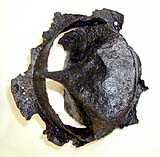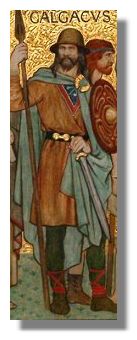
"Historians have long assumed that the reviled Roman emperor Maxentius lived part-time at an 80-acre suburban villa complex until he was killed by his rival Constantine at the Battle of the Milvian Bridge in A.D. 312.
But a University of Colorado-led archaeology team has uncovered evidence that the villa's main hall was never occupied.
Instead, it appears to have been abandoned before completion, said CU archaeologist Diane Conlin, co-director of the Maxentius project, a five-year excavation that began last summer.
'Maxentius builds a lot in Rome during his extremely short reign,' Conlin said. 'And the pattern - up to our project - is that Constantine either finishes the buildings and takes them over, or he demolishes them and builds something new.
'But this (villa) stands outside that pattern of behavior,' she said. 'Instead of being finished or demolished, it was abandoned.'
Marcus Aurelius Valerius Maxentius ruled Rome from A.D. 306 to 312, a time when the empire was in 'a holding pattern at the end of its period of greatness,' said CU historian Noel Lenski. Maxentius, son of the emperor Maximian, was in his 20s when he took power.
At the villa complex about two miles south of Rome's center and just outside the city's defensive walls, Maxentius built a chariot course with grandstand seating for 30,000 and monuments to his only son, Romulus. The boy was 9 when he drowned in the Tiber River, the same fate Maxentius met at the Milvian Bridge.
The day after that battle, Maxentius' armor-clad body was fished from the Tiber mud by Constantine's troops. His head was lopped off and displayed as 'an emblem of victory and conquest,' Conlin said.
Constantine reportedly had a vision of God the night before the battle and converted to Christianity on the spot.
But Maxentius was a pagan. Archaeologists wonder if his villa project on the Via Appia - the first and most well-known ancient Roman road - was an attempt to strengthen ties with Christians, Conlin said.
"One major question that we hope to answer is why Maxentius built this grand villa complex outside the defensive walls of the city when he had full control of pre-existing imperial palaces located in the heart of the capital," she said.
Limited investigations of the villa site were conducted in 1825 and again in the 1960s. Italian archaeologists exposed exterior walls but didn't dig into the interior of the large main hall, or basilica, Conlin said.
CU archaeologists and their colleagues sank two trenches in the main hall during a five-week field season last summer. Two more trenches will be opened in the basilica this summer. Twenty students from CU and Kalamazoo College in Michigan joined in the 2005 work.
After digging through modern garbage deposits and cemented chunks of architectural debris, the team reached the ancient basilica and found "a bare skeleton of brick and concrete," Conlin said.
A finished basilica from the period would feature stone mosaics on the floor and decorative marble slabs on the walls. The researchers found 800 pounds of marble fragments, but no piece was bigger than 12 inches by 6 inches. Instead of mosaic floors, they found only a brick subfloor.
"It seems like no one ever lived there," Lenski said. "It was 85 to 90 percent completed. It was the finishing touches that were left off."
The marble fragments suggest that bigger slabs had been installed but were later hauled away."
 new museum has taken 10 years to be realized. But even now, as work continues on the $24 million glass and travertine marble structure, which stands between a busy highway overlooking the River Tiber and the Mausoleum of Augustus, Rome's mayor, Walter Veltroni, went ahead with its scheduled inauguration on Friday because April 21 was, at least in theory, the city's 2,759th birthday.
new museum has taken 10 years to be realized. But even now, as work continues on the $24 million glass and travertine marble structure, which stands between a busy highway overlooking the River Tiber and the Mausoleum of Augustus, Rome's mayor, Walter Veltroni, went ahead with its scheduled inauguration on Friday because April 21 was, at least in theory, the city's 2,759th birthday.



 Savage violence and mutilation, typical of battlefields at the time, was not the order of the day in the arena. Death for the vanquished was relatively swift and merciful.
Savage violence and mutilation, typical of battlefields at the time, was not the order of the day in the arena. Death for the vanquished was relatively swift and merciful. 










 field were the vast legions of the mighty Roman Empire. On the other, a 30,000-strong confederate army of Caledonians ? our Scottish ancestors. This encounter, which became known as Mons Graupius, was a key moment for the Romans in their almighty struggle to conquer the whole of Britain. For the Scots, it was a battle for survival against a brutal occupation.
field were the vast legions of the mighty Roman Empire. On the other, a 30,000-strong confederate army of Caledonians ? our Scottish ancestors. This encounter, which became known as Mons Graupius, was a key moment for the Romans in their almighty struggle to conquer the whole of Britain. For the Scots, it was a battle for survival against a brutal occupation.



